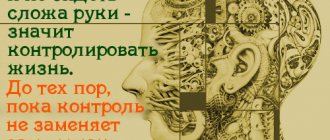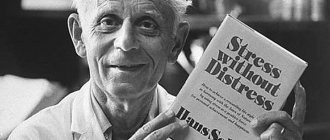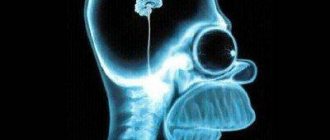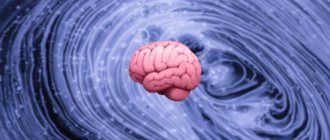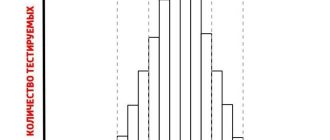In general, intelligence is a system of mental mechanisms that make it possible to construct a subjective picture of what is happening “inside” an individual.
From a psychological point of view, the purpose of intelligence is to create order out of chaos by aligning individual needs with the objective requirements of reality.
All those areas of human activity where it is necessary to learn something, do something new, make a decision, understand, explain, discover - all this is the sphere of action of the intellect.
The main theories of intelligence include:
- Psychometric theories of intelligence
- Hierarchical theories of intelligence
- Cognitive theories of intelligence
- Multiple theories of intelligence
- Gestalt psychological theory of intelligence
- Ethological theory of intelligence
- Operational theory of intelligence
- Structural-level theory of intelligence
Psychometric theories of intelligence
These theories claim that individual differences in human cognition and mental abilities can be adequately measured by special tests. Adherents of psychometric theory believe that people are born with different intellectual potential, just as they are born with different physical characteristics, such as height and eye color. They also argue that no amount of social programs can transform people with different mental abilities into intellectually equal individuals.
Psychometric theories of intelligence:
- Ch. Spearman's two-factor theory of intelligence.
- Theory of primary mental abilities.
- Cubic model of the structure of intelligence.
Ch. Spearman's two-factor theory of intelligence. Charles Spearman, an English statistician and psychologist, creator of factor analysis, he drew attention to the fact that there are correlations between different intelligence tests: those who perform well on some tests turn out, on average, to be quite successful on others. The structure of intellectual properties proposed by Charles Spearman turns out to be extremely simple and is described by two types of factors - general and specific. These two types of factors gave the name to Charles Spearman's theory - the two-factor theory of intelligence.
The main postulate of Charles Spearman's theory remained unchanged: individual differences between people in intellectual characteristics are determined primarily by general abilities.
Theory of primary mental abilities. In 1938, Lewis Thurston's work “Primary Mental Abilities” was published, in which the author presented a factorization of 56 psychological tests diagnosing various intellectual characteristics. The structure of intelligence according to L. Thurston is a set of mutually independent and adjacent intellectual characteristics, and in order to judge individual differences in intelligence, it is necessary to have data on all these characteristics.
In the works of L. Thurston's followers, the number of factors obtained by factorizing intellectual tests (and, consequently, the number of intellectual characteristics that must be determined when analyzing the intellectual sphere) was increased to 19. But, as it turned out, this was far from the limit.
Cubic model of the structure of intelligence. The largest number of characteristics underlying individual differences in the intellectual sphere was named by J. Guilford. According to the theoretical concepts of J. Guilford, the implementation of any intellectual task depends on three components - operations, content and results.
Operations represent those skills that a person must demonstrate when solving an intellectual problem.
The content is determined by the form in which the information is presented. Information can be presented in visual and auditory form, may contain symbolic material, semantic (i.e. presented in verbal form) and behavioral (i.e. discovered when communicating with other people, when it is necessary to understand from the behavior of other people how respond correctly to the actions of others).
Results - what a person ultimately arrives at when solving an intellectual problem - can be presented in the form of single answers, in the form of classes or groups of answers. While solving a problem, a person can also find the relationship between different objects or understand their structure (the system underlying them). He can also transform the final result of his intellectual activity and express it in a completely different form than the one in which the source material was given. Finally, he can go beyond the information given to him in the test material and find the meaning or hidden meaning behind this information, which will lead him to the correct answer.
The combination of these three components of intellectual activity - operations, content and results - forms 150 characteristics of intelligence (5 types of operations multiplied by 5 forms of content and multiplied by 6 types of results, i.e. 5x5x6 = 150). For clarity, J. Guilford presented his model of the structure of intelligence in the form of a cube, which gave the name to the model itself. However, the mutual independence of these factors is constantly questioned, and the very idea of J. Guilford about the existence of 150 separate, unrelated intellectual characteristics does not meet with sympathy among psychologists involved in the study of individual differences: they agree that the entire variety of intellectual characteristics cannot be reduced to one general factor, but compiling a catalog of one hundred and fifty factors represents the other extreme. It was necessary to look for ways that would help organize and correlate the various characteristics of intelligence with each other.
Odds information
Contrary to popular belief, it is extremely difficult to measure intelligence because, as mentioned, it consists of many different abilities.
And even existing tests created by famous psychologists cannot be considered an ideal measurement method: they often measure only some of the components of intelligence.
They are convenient to use to identify people with insufficient intellectual abilities, which helps in diagnosing some diseases, but they are difficult to find geniuses with their help, since genius is also a complex structure consisting of many components.
The most well-known tests that reveal IQ are:
- Hans Eysenck test;
- Raven's test (Raven);
- Wechsler test.
Tests showing IQ levels have been repeatedly criticized by various researchers, for example, mathematician Viktor Vasiliev, who found errors in the Eysenck questionnaire.
It has also been noted that IQ level weakly correlates with the likelihood that a person will achieve success in life and be happy.
The type of intelligence that can be measured using the above tests is called psychometric . Its manifestations are quite simple to identify and record.
Data:
- It is extremely important that a person at the formation stage (during pregnancy and childhood) receives a sufficient amount of iodine . The average IQ in regions where children and pregnant women do not receive enough iodine is 10-15 points lower than in regions where this problem does not exist.
- People with a high IQ are more likely to suffer from mental illness , especially anxiety disorder.
- Marilyn vos Savant is an American woman with the highest IQ in the world: 228. She is a journalist and writes books.
The degree of development of emotional intelligence (EQ) is of great importance. People with developed EQ find it easier to interact with others, adapt in society and achieve success at work.
Hierarchical theories of intelligence
By the beginning of the 50s, works appeared in which it was proposed to consider various intellectual characteristics as hierarchically organized structures.
In 1949, the English researcher Cyril Burt published a theoretical scheme according to which there are 5 levels in the structure of intelligence. The lowest level is formed by elementary sensory and motor processes. A more general (second) level is perception and motor coordination. The third level is represented by the processes of skill development and memory. An even more general level (fourth) are processes associated with logical generalization. Finally, the fifth level forms the general intelligence factor (g). S. Burt's scheme practically did not receive experimental verification, but it was the first attempt to create a hierarchical structure of intellectual characteristics.
The most famous hierarchical structure of intelligence in modern psychology was proposed by the American researcher Raymond Cattell. R. Cattell and his colleagues suggested that individual intellectual characteristics identified on the basis of factor analysis (such as L. Thurston’s primary mental abilities or J. Guilford’s independent factors), with secondary factorization, will be combined into two groups or, in the authors’ terminology, into two broad factors. One of them, called crystallized intelligence, is associated with the knowledge and skills that are acquired by a person - “crystallized” in the learning process. The second broad factor, fluid intelligence, has less to do with learning and more to do with the ability to adapt to unfamiliar situations. The higher the fluid intelligence, the easier a person copes with new, unusual problem situations.
Both crystallized and fluid intelligence have proven to be fairly general dimensions of intelligence that account for individual differences in performance on a wide range of intelligence tests. Thus, the structure of intelligence proposed by R. Cattell is a three-level hierarchy. The first level represents primary mental abilities, the second level represents broad factors (fluid and crystallized intelligence), and the third level represents general intelligence.
To summarize the works that proposed hierarchical structures of intelligence, we can say that their authors sought to reduce the number of specific intellectual characteristics that constantly appear in the study of the intellectual sphere. They tried to identify secondary factors that are less general than the g factor, but more general than the various intellectual characteristics related to the level of primary mental abilities. The proposed methods for studying individual differences in the intellectual sphere are test batteries that diagnose psychological characteristics described precisely by these secondary factors.
The role of G factor
Spearman argued that the success of any intellectual activity depends on both general intelligence and specific intelligence for a given activity. Moreover, he noticed that the role of G- and S-factors is different for different types of activity. General intelligence is most important when performing tasks on conceptual thinking and solving complex mathematical problems, and least important when performing sensorimotor actions.
Although the factor of general intelligence has a great influence on our activities, it is of a latent nature and is very weakly manifested. The greatest correlation with the G-factor is shown by simple tests (for example, Raven matrices), which track not the ability to cope with a task, but the speed of solving it. And here we come to clearer criteria for general intelligence.
Cognitive theories of intelligence
Cognitive theories of intelligence suggest that a person's level of intelligence is determined by the efficiency and speed of information processing processes. According to cognitive theories, the speed of information processing determines the level of intelligence: the faster information is processed, the faster the test task is solved and the higher the level of intelligence turns out to be. As indicators of the information processing process (as components of this process), any characteristics that may indirectly indicate this process can be selected - reaction time, brain rhythms, various physiological reactions. As a rule, various speed characteristics are used as the main components of intellectual activity in studies conducted in the context of cognitive theories.
Multiple theories of intelligence
The theory of multiple intelligences by the American psychologist Howard Gardner, which was first published over two decades in his book “Frames of the Mind: The Theory of Multiple Intelligences,” reveals one of the possible images of individualization of the educational process. This theory has received worldwide recognition as one of the most innovative theories of human intelligence. The theory of multiple intelligences confirms what educators deal with every day: people think and learn in many different ways.
The theory of triple intelligence. The author of this theory, American researcher Robert Sternberg, believes that a holistic theory of intelligence should describe its three aspects - internal components associated with information processing (component intelligence), the effectiveness of mastering a new situation (experiential intelligence) and the manifestation of intelligence in a social situation (situational intelligence). ). In component intelligence, R. Sternberg distinguishes three types of processes or components. Performing components are the processes of perceiving information, storing it in short-term memory, and retrieving information from long-term memory; they are also associated with counting and comparing objects. Components associated with the acquisition of knowledge determine the processes of obtaining new information and storing it. Metacomponents control performance components and knowledge acquisition; they also define strategies for solving problem situations. As research by R. Sternberg has shown, the success of solving intellectual problems depends, first of all, on the adequacy of the components used, and not on the speed of information processing. Often a more successful solution is associated with a greater investment of time.
Theory of multiple intelligences. Howard Gardner's theory, like the theories of R. Sternberg and G. Eysenck described here, uses a broader view of intelligence than that offered by psychometric and cognitive theories. H. Gardner believes that there is no single intelligence, but there are at least 6 separate intelligences. Three of them describe traditional theories of intelligence - linguistic, logical-mathematical and spatial. The other three, although they may seem strange at first glance and not related to the intellectual sphere, deserve, in the opinion of H. Gardner, the same status as traditional intellects. These include musical intelligence, kinesthetic intelligence and personal intelligence.
Musical intelligence is concerned with rhythm and hearing, which are the basis of musical ability. Kinesthetic intelligence is defined by the ability to control your body. Personal intelligence is divided into two - intrapersonal and interpersonal. The first of them is associated with the ability to manage one’s feelings and emotions, the second with the ability to understand other people and predict their actions.
Gestalt psychological theory of intelligence
One of the first attempts to construct an explanatory model of intelligence was presented in Gestalt psychology, within which the nature of intelligence was interpreted in the context of the problem of organizing the phenomenal field of consciousness. The prerequisites for this approach were set by W. Köhler. As a criterion for the presence of intellectual behavior in animals, he considered the effects of structure: the emergence of a solution is due to the fact that the field of perception acquires a new structure, which captures the relationships between the elements of the problem situation that are important for its resolution. The decision itself arises suddenly, based on an almost instantaneous restructuring of the image of the initial situation (this phenomenon is called insight). Subsequently, M. Wertheimer, characterizing the “productive thinking” of a person, also brought to the fore the processes of structuring the content of consciousness: grouping, centering, reorganization of available impressions.
The main vector along which the image of the situation is being restructured is its transition to a “good gestalt”, that is, an extremely simple, clear, dissected, meaningful image, in which all the main elements of the problem situation are fully reproduced, first of all, its key structural contradiction. As a modern illustration of the role of the image structuring process, we can use the well-known “four points” problem: “given four points. You need to cross them out with three straight lines, without lifting the pencil from the paper, and at the same time return to the starting point.” The principle of solving this problem is to rebuild the image: get away from the image of the “square” and see the continuation of the lines beyond the dots. In short, a distinctive feature of the involvement of the intellect in the work is such a reorganization of the content of consciousness, thanks to which the cognitive image acquires the “quality of form.”
A special place in Gestalt psychological theory was occupied by the research of K. Duncker, who managed to describe the solution to a problem from the point of view of how the content of the subject’s consciousness changes in the process of finding the principle (idea) of the solution. The key characteristic of intelligence is insight (sudden, unexpected understanding of the essence of the problem). The deeper the insight, that is, the more strongly the essential features of the problem situation determine the response action, the more intellectual it is. According to Duncker, the deepest differences between people in what we call mental giftedness have their basis precisely in the greater or lesser ease of restructuring of mental material. Thus, the ability to gain insight (that is, the ability to quickly rearrange the content of a cognitive image in the direction of identifying the main problematic contradiction of the situation) is a criterion for the development of intelligence.
Question 1 Concept and structure of intelligence
Page 1 of 8Next ⇒Question 1 Concept and structure of intelligence
In everyday communication, the concepts of “ability” and “intelligence” are often used as synonyms. This is not surprising, since it is difficult to imagine a capable, gifted or brilliant person with low intelligence. In this regard, it is advisable to consider intelligence within the framework of the problem of abilities.
Intelligence is one of the most complex mental abilities of an individual.
In understanding its essence, the opinions of psychologists differ. Difficulties arise even in the very definition of intelligence. Here are some of the definitions.
Intelligence is the ability to think. Intelligence is a type of adaptive behavior aimed at achieving a goal. Intelligence is a characteristic of the rational thinking functions of the human psyche. Intelligence is a holistic characteristic of human cognitive processes. Intelligence is a person's ability to adapt to the environment. Intelligence is a concept designed to explain why people differ in solving complex problems. Intelligence is a person’s global ability to act intelligently, think rationally, and cope well with life’s circumstances. Intelligence is a relatively stable structure of an individual's mental abilities.
A generalized definition may look like this: intelligence is a system of mental processes that allow a person to use his abilities to assess a situation, make rational decisions and organize appropriate behavior in a changing environment.
In the problem of intelligence, a clear boundary is not established between the concepts of “intelligence,” “mind,” and “thinking,” which consider different but interrelated aspects of personality. An attempt to correlate these concepts within the framework of the general problem of human abilities leads to the following diagram.
Intelligence can be thought of as the ability to think.
At the same time, intelligence is not linked to morality, empathy, love of humanity, profession, or even elite education. Obviously, this is exactly what A. Einstein meant: “You should not deify the intellect. He has powerful muscles, but no face."
Thinking is the process through which intelligence is manifested and realized. Mind is a generalized characteristic of a person’s cognitive capabilities and the thinking process. The mind is a whole complex of qualities, so closely related that, taken separately, they manifest themselves differently. When a person is called smart, this assessment refers simultaneously to many of his qualities.
As for the structure of intelligence, at present, due to the complexity of both the phenomenon itself and the imperfection of its formulation, it is difficult to offer a full-fledged model of it. Information on this unique mental formation is being accumulated. In the meantime, the available results are largely due to the specifics of the scientific positions of scientists. The concept of intelligence includes from several to dozens of factors. Naturally, this makes it difficult to assess intelligence as a holistic phenomenon.
In the structure of intelligence, various researchers identify several components:
General intelligence
(Factor G, from the English general - general) is a set of mental properties of a person that predetermine the success of any activity, adaptation to the environment and a high rate of information processing. General intelligence comes from general abilities. For example, a person’s communication abilities are in demand by many types of activities: managerial, pedagogical, artistic, diplomatic.
Special Intelligence
(Factor S, from the English spesial - special) - a set of mental properties that are necessary to solve narrow problems in a particular type of activity. This type of intelligence is provided by special human abilities. Examples of special intelligence include: - professional intelligence, focused on the specialization of activities (musical, mathematical); — social intelligence, focused on problems of interpersonal relationships, interaction of business partners.
Potential intelligence
- determines a person’s ability to think, abstract and reason. The name is due to the fact that this intelligence “matures” at about 20 years of age (according to R. Kettell).
Crystal Intelligence
- “crystallized” in a person in the process of accumulating knowledge, skills and abilities while adapting to the environment and assimilating the values of society.
Intelligence A is the innate part of intelligence, its “humus”.
Intelligence B is the result of the interaction of intelligence A with the environment around a person during his life.
There are other approaches to understanding the structure of human intelligence. Thus, L. Thurstone identified a set of 12 independent abilities that determine intelligence, calling them primary mental potencies (speed of perception, associative memory, verbal flexibility, etc.). D. Guilford’s “cubic” model of intelligence includes 120 components that characterize the content of mental activity (what an individual’s thoughts are occupied with), its operations (how it is implemented) and the result of mental activity (to what form the processed information is brought).
Thus, despite all the differences in views on the problem, the common thing is the multicomponent nature of the phenomenon of “intelligence”, its close connection with cognitive mental processes, innate and social factors.
Question 3 Piaget's concept of intellectual development
See notebook
Question 4 of the position of the psychological nature of intelligence
Several positions can be distinguished in understanding the psychological nature of intelligence.
1. Intelligence is a general ability that determines the success of performing any tasks (cognitive, social). Ability is understood as: 1) cognitive abilities, differing in varying degrees of specificity for a particular activity; 2) the ability to systematically organize the whole, with instant identification of the main problematic contradiction of the initial situation; 3) the ability to independently acquire new knowledge; 4) adaptive ability.
2. In the structure of intelligence, a distinction is made between innate abilities, independent of the degree of involvement in a culture, and knowledge and mental skills acquired during socialization. Innate abilities come down to the psychophysiological properties of the central nervous system. Acquired knowledge and mental skills are a measure of mastery of the culture of the society to which the individual belongs.
3. The difficulty in distinguishing between innate abilities and acquired knowledge and mental skills may lead to their identification. In this case, intelligence is identified with mental development.
4. The main trend of socio-cultural influences on human cognitive abilities is the emergence of the ability for categorical thinking. In the context of cultural and historical studies, intelligence is identified with conceptual thinking.
5. Intelligence is understood as a system of cognitive processes. The interpretation of the nature of cognitive processes differs: processes responsible for processing information (methodological solipsism); forms of active cognitive reflection of reality (activity theory).
6. Inclusion of regulatory and motivational components into the structure of intelligence.
7. The operational-process approach in the analysis of intellectual activity allows us to separate the concepts of thinking and mental abilities. Thinking is a continuous process of analysis, synthesis, generalization of the conditions and requirements of the problems being solved and methods for solving them. Mental abilities are a set of mental operations formed in the process of thinking, which thinking generates, but which cannot be reduced to.
Question 5 theory of intelligence
Based on the study of the organization of active cognitive actions, models of intelligence by B. G. Ananyev and B. M. Velichkovsky were developed (action as a unit of human sensory activity, practice).
In the theory of intelligence, developed under the leadership of B. G. Ananyev, intelligence is an integrated system of cognitive processes. The structure of intelligence comes down to the nature of intrafunctional and interfunctional connections identified using correlation and factor analysis procedures (cognitive differentiation-integration, leading mental process, etc.). The degree of integration of cognitive processes (psychomotor skills, attention, memory, thinking) is a criterion for the development of intelligence. Integration is characterized by an increase in the severity of the properties of individual cognitive functions and strengthening of interfunctional connections between them. The increase in the number and magnitude of correlations is interpreted as a manifestation of the degree of integration of cognitive functions and, accordingly, as an indicator of the formation of an integral structure of intelligence.
Within the framework of B. M. Velichkovsky’s theory of the functional organization of cognitive processes, intelligence is considered as a heterarchy of levels of cognitive reflection. Unlike hierarchies, heterarchies do not have a fixed “center” from which the entire system is controlled. Goals are distributed among several relatively autonomous levels. The heterarchical (polyphonic) principle of coordination of cognitive processes emphasizes the independent nature of the functioning of each level of cognitive reflection.
Six levels are identified - A, B, C, D, E, F. The lower levels (A, B) are associated with the implementation of movements and the localization of objects in space, suggesting an accurate metric reference to the relevant properties of objects. Levels C and D coordinate detailed substantive actions in the conditions of constructing a substantive image of the situation. Levels E, F are “higher symbolic coordination”, responsible for the representation and storage of knowledge and strategies for transforming knowledge. Basic levels of cognitive reflection characterize the nature of individual cognitive processes: sensation is associated with the work of levels A, B, C, perception - C, D, memory and thinking - D, E, F, imagination and understanding - E, F, attention - the result of influence control level F to E and E to D.
For Alzheimer's disease.
on gradual, progressive, diffuse atrophy of the brain with the death of neurons, mainly in the frontal and temporal parts of the brain. Alzheimer's disease in 50% of cases affects elderly people aged 65-70 years and older.
The syndrome was described by the German psychiatrist Alzheimer (A. Alzheimer) in 1906.
The clinical picture of the disease is characterized by irritability, rapid fatigue, deterioration of sleep, deterioration of abstract thinking, short- and long-term memory, attention, behavioral disturbances in the form of viscosity, and various types of accentuation. The patients themselves try to hide the decline in intelligence from others, but the progressive destruction of vocabulary, meaningless repetition of phrases, individual words, talking with one’s reflection in the mirror, thoroughness of thinking, loss of self-care skills, disorientation in place, in time, difficulties in counting, writing, change gait (slow and shuffling) makes the diagnosis obvious. Gradually, the above-described symptoms are replenished by the development of various types of speech and gnostic-praxic disorders (aphasia, agnosia, apraxia). In 75% of cases, patients experience epileptic seizures.
Death occurs approximately 2-8 years from the onset of the disease from an infection associated with the disease.
against the background of a deep degree of intellectual deficiency and complete adynamia (immobility).
Vascular dementia.
Vascular dementia is the result of progressive atherosclerosis of the brain vessels, when sclerotic plaques form on the inner surface of the vessels, reducing the lumen of the vessels, which in turn leads to a decrease in nutrition (hypoxia) of the brain substance and the development of various psycho-neurological disorders, and above all intellectual disability .
Vascular dementia can also develop in people who have suffered a cerebral stroke, regardless of the patient’s age and the presence of atherosclerotic manifestations.
The clinical picture of the disease against the background of general manifestations is characterized by uneven expressed disturbances of higher brain functions, the presence of focal neurological symptoms (aphasia, hemiparesis, the presence of pathological reflexes, pseudobulbar palsy, etc.). Unlike Alzheimer's disease, with vascular dementia, patients, as a rule, are aware of their intellectual deficiency and experience it deeply.
One of the early signs of vascular dementia is a sharp deterioration in memory for immediate events. Patients forget what they did recently, they put something somewhere and cannot find what they ate for breakfast, etc., but they perfectly remember events that took place in their lives many years ago.
Dementia in Pick's disease.
The syndrome was first described by the Czech neurologist and psychiatrist A. Pick in 1982.
The clinical picture of the disease is almost similar to Alzheimer's disease, but it has a number of distinctive features specifically in the development of intellectual impairments. This is, first of all, a slow increase in intellectual disorders, relative preservation of memory and functions of the parietal parts of the cerebral cortex, early cortical speech disorders in the form of aphasia. A characteristic symptom of dementia in Pick's disease is the so-called “gramophone symptom,” when the patient tells what seems most interesting to him, and it is practically impossible to interrupt this story; after finishing the story, after some time, he can repeat it again, using the same words and sentences as the first time.
Question #51
Heller's syndrome (childhood dementia - dementia infantilis) -
a disintegrative disorder of childhood, characterized by the progressive development of dementia syndrome.
The syndrome was first described in 1909 by the German physician In. Heller and the Austrian physician J. Zappert in 1911.
The cause of the disease is some unknown neurological dysfunction, but it is noted that the onset of the disease is often preceded by a stressor.
In the initial stage of the disease (2-6 years), changes in speech are noted in the form of unclearness and blurring, up to babbling. Subsequently, the skills of reproducing and understanding speech are completely lost. The loss of motor skills is manifested by the appearance of stereotypical movements, grimaces and tics, and epileptic seizures are often associated. Control over independent nutrition, as well as over the functions of the pelvic organs, is lost. The child's emotional state changes. He becomes irritable and sometimes has outbursts of anger and aggression.
The listed clinical manifestations are usually accompanied by pseudobulbar disorders (violent laughter and crying).
Subsequently, there is a complete loss of skills and knowledge, manifested by the clinic of profound dementia.
The duration of the disease (from the initial to the final stage - the stage of dementia) - from one year to several years.
The prognosis is unfavorable due to the lack of regression of clinical manifestations.
Krammer-Pollnow syndrome is a psychopathological symptom complex that includes a kind of hyperkinetic psychosis with the development of intellectual disability. First described by the German neurologist and psychiatrist Krammer and Pollnov (F. Krammer, H. Pollnov) in 1930-1932.
The clinical picture of the syndrome is characterized by the rapid and severe development of aimless motor restlessness (“mercurial movements”; the child does not remain calm for a moment). Stereotyped rhythmic motor acts are often detected. Changes in the emotional sphere are noted (attacks of anger, rage, mood lability, irritability). A suspension or slowdown in further motor and speech development is clearly visible.
A characteristic feature of this pathology is that after the maximum severity of symptoms (by 6 years), patients experience regression (within 1-2 years), sometimes until complete recovery. But in most cases, children remain intellectually impaired and prone to epileptiform seizures.
Asperger's syndrome.
Asperger's syndrome clinically resembles childhood autism and is characterized by severe awkwardness in communication, silence, isolation, lack of interest in the interlocutor's speech, poor facial expressions and gestures, changes in the grammatical aspect of speech, and decreased intelligence. Unlike autism, Asperger syndrome does not have a general delay or retardation in speech and there is a higher level of intellectual development.
It was first described in 1944 by the Viennese child psychiatrist Hans Asperger, who designated it as autistic psychopathy.
Movements.
This disorder is characterized by the following clinical manifestations:
■=> persistent and almost constant motor restlessness;
■=> frequently repeated motor stereotypes (for example, clapping your hands);
■=> severe mental retardation.
In adolescence, cases of transition from hyperactivity to a state of inhibition are often observed.
Hyperactive disorder combined with mental retardation and stereotypical
Acute reaction to stress.
Acute stress reaction is a transient mental disorder (from several hours to several days) that develops in response to physical or psychological stress.
The clinical picture is characterized by a short-term state of “stupefaction”, a temporary weakening of intelligence, disorientation in place and an inadequate response to external stimuli. Partial or complete dissociative amnesia for previous events is often noted. A characteristic symptom complex of this condition is vegetative-vascular disorders in the form of tachycardia, hyperhidrosis of the skin, hyperemia of the face and body, etc.
In cases of deep perception of the stress factor in many patients, the above manifestations may be accompanied by more pronounced inhibition, up to dissociative stupor.
Question 1 Concept and structure of intelligence
In everyday communication, the concepts of “ability” and “intelligence” are often used as synonyms. This is not surprising, since it is difficult to imagine a capable, gifted or brilliant person with low intelligence. In this regard, it is advisable to consider intelligence within the framework of the problem of abilities.
Intelligence is one of the most complex mental abilities of an individual.
In understanding its essence, the opinions of psychologists differ. Difficulties arise even in the very definition of intelligence. Here are some of the definitions.
Intelligence is the ability to think. Intelligence is a type of adaptive behavior aimed at achieving a goal. Intelligence is a characteristic of the rational thinking functions of the human psyche. Intelligence is a holistic characteristic of human cognitive processes. Intelligence is a person's ability to adapt to the environment. Intelligence is a concept designed to explain why people differ in solving complex problems. Intelligence is a person’s global ability to act intelligently, think rationally, and cope well with life’s circumstances. Intelligence is a relatively stable structure of an individual's mental abilities.
A generalized definition may look like this: intelligence is a system of mental processes that allow a person to use his abilities to assess a situation, make rational decisions and organize appropriate behavior in a changing environment.
In the problem of intelligence, a clear boundary is not established between the concepts of “intelligence,” “mind,” and “thinking,” which consider different but interrelated aspects of personality. An attempt to correlate these concepts within the framework of the general problem of human abilities leads to the following diagram.
Intelligence can be thought of as the ability to think.
At the same time, intelligence is not linked to morality, empathy, love of humanity, profession, or even elite education. Obviously, this is exactly what A. Einstein meant: “You should not deify the intellect. He has powerful muscles, but no face."
Thinking is the process through which intelligence is manifested and realized. Mind is a generalized characteristic of a person’s cognitive capabilities and the thinking process. The mind is a whole complex of qualities, so closely related that, taken separately, they manifest themselves differently. When a person is called smart, this assessment refers simultaneously to many of his qualities.
As for the structure of intelligence, at present, due to the complexity of both the phenomenon itself and the imperfection of its formulation, it is difficult to offer a full-fledged model of it. Information on this unique mental formation is being accumulated. In the meantime, the available results are largely due to the specifics of the scientific positions of scientists. The concept of intelligence includes from several to dozens of factors. Naturally, this makes it difficult to assess intelligence as a holistic phenomenon.
In the structure of intelligence, various researchers identify several components:
General intelligence
(Factor G, from the English general - general) is a set of mental properties of a person that predetermine the success of any activity, adaptation to the environment and a high rate of information processing. General intelligence comes from general abilities. For example, a person’s communication abilities are in demand by many types of activities: managerial, pedagogical, artistic, diplomatic.
Special Intelligence
(Factor S, from the English spesial - special) - a set of mental properties that are necessary to solve narrow problems in a particular type of activity. This type of intelligence is provided by special human abilities. Examples of special intelligence include: - professional intelligence, focused on the specialization of activities (musical, mathematical); — social intelligence, focused on problems of interpersonal relationships, interaction of business partners.
Potential intelligence
- determines a person’s ability to think, abstract and reason. The name is due to the fact that this intelligence “matures” at about 20 years of age (according to R. Kettell).
Crystal Intelligence
- “crystallized” in a person in the process of accumulating knowledge, skills and abilities while adapting to the environment and assimilating the values of society.
Intelligence A is the innate part of intelligence, its “humus”.
Intelligence B is the result of the interaction of intelligence A with the environment around a person during his life.
There are other approaches to understanding the structure of human intelligence. Thus, L. Thurstone identified a set of 12 independent abilities that determine intelligence, calling them primary mental potencies (speed of perception, associative memory, verbal flexibility, etc.). D. Guilford’s “cubic” model of intelligence includes 120 components that characterize the content of mental activity (what an individual’s thoughts are occupied with), its operations (how it is implemented) and the result of mental activity (to what form the processed information is brought).
Thus, despite all the differences in views on the problem, the common thing is the multicomponent nature of the phenomenon of “intelligence”, its close connection with cognitive mental processes, innate and social factors.
1Next ⇒
Ethological theory of intelligence
According to W. Charlesworth, a proponent of the ethological approach to explaining the nature of intelligence, the starting point in his research should be the study of behavior in the natural environment. Intelligence, therefore, is a way of adapting a living being to the requirements of reality, formed in the process of evolution. For a better understanding of the adaptive functions of intelligence, he proposes to distinguish between the concept of “intelligence,” which includes existing knowledge and already formed cognitive operations, and the concept of “intellectual behavior,” which includes means of adaptation to problematic (new, difficult) situations, including cognitive processes that organize and control behavior.
A look at intelligence from the perspective of the theory of evolution led W. Charlesworth to the conclusion that the deep mechanisms of that mental property that we call intelligence are rooted in the innate properties of the nervous system.
It is curious that the ethological approach (with its focus on the study of intellectual activity in everyday life in the context of the natural environment) brought to the fore the phenomenon of common sense (a kind of “naive theory of human behavior”). Unlike fantasy dreams and scientific thinking, common sense, on the one hand, has a realistic and practical orientation and, on the other hand, is motivated by needs and desires. Thus, common sense is situationally specific and at the same time individually specific - this is what explains its key role in organizing the adaptation process.
Operational theory of intelligence
According to J. Piaget, intelligence is the most perfect form of adaptation of the body to the environment, representing the unity of the assimilation process (reproduction of environmental elements in the subject’s psyche in the form of cognitive mental schemes) and the accommodation process (changes in these cognitive schemes depending on the requirements of the objective world). Thus, the essence of intelligence lies in the ability to carry out flexible and at the same time stable adaptation to physical and social reality, and its main purpose is to structure (organize) a person’s interaction with the environment.
The development of intelligence is a spontaneous process, subject to its own special laws, of the maturation of operational structures (schemes) that gradually grow out of the child’s objective and everyday experience.
Consequently, intellectual development is the development of the operational structures of the intellect, during which mental operations gradually acquire qualitatively new properties: coordination (interconnectedness and consistency of many operations), reversibility (the ability at any time to return to the starting point of one’s reasoning, to move on to considering an object directly). the opposite point of view, etc.), automation (involuntariness of application), abbreviation (collapse of individual links, “instantaneity” of actualization).
Structural-level theory of intelligence
A number of essential provisions regarding the nature of human intellectual capabilities are formulated within the framework of the theory of intelligence, developed under the leadership of B. Ananyev. The starting point was the idea that intelligence is a complex mental activity, representing a unity of cognitive functions at different levels. Within the framework of this theory, the thesis about intelligence as the effect of interfunctional connections of basic cognitive processes at different levels of cognitive reflection was developed. In particular, as part of the empirical study, cognitive functions such as psychomotor skills, attention, memory and thinking were studied, which were considered as components of the intellectual system.
Experimental studies by B. Ananyev and his colleagues allowed them to draw a number of important conclusions regarding the functional-level structure of intelligence.
B. Ananyev constantly emphasized the deep unity of the theory of intelligence and the theory of personality. On the one hand, needs, interests, attitudes and other personal qualities determine the activity of the intellect. On the other hand, the characterological properties of a person and the structure of motives depend on the degree of objectivity of his relationship to reality, the experience of knowing the world and the general development of intelligence.
0
Intellectualization in psychology
Intellectualization is one of the forms of psychological defense in which a person closes himself off from his sensory sensations and begins to perceive what he feels on an intellectual level. This helps reduce the influence of emotions on behavior and decisions, and act more wisely and correctly.
But any protective mechanisms of the psyche negatively affect how an individual perceives reality and himself . In this case, intellectualization leads to the fact that the individual ceases to realize the importance of his emotional state.
People who actively use such defenses have difficulty expressing emotions , which complicates interaction with others, especially in the case of close social relationships (love, friendship).
It is considered an integral part of the personality of schizoids (both schizoid accentuation and schizoid personality disorder are implied).
Read about the symptoms and treatment of emotional personality disorder here.

